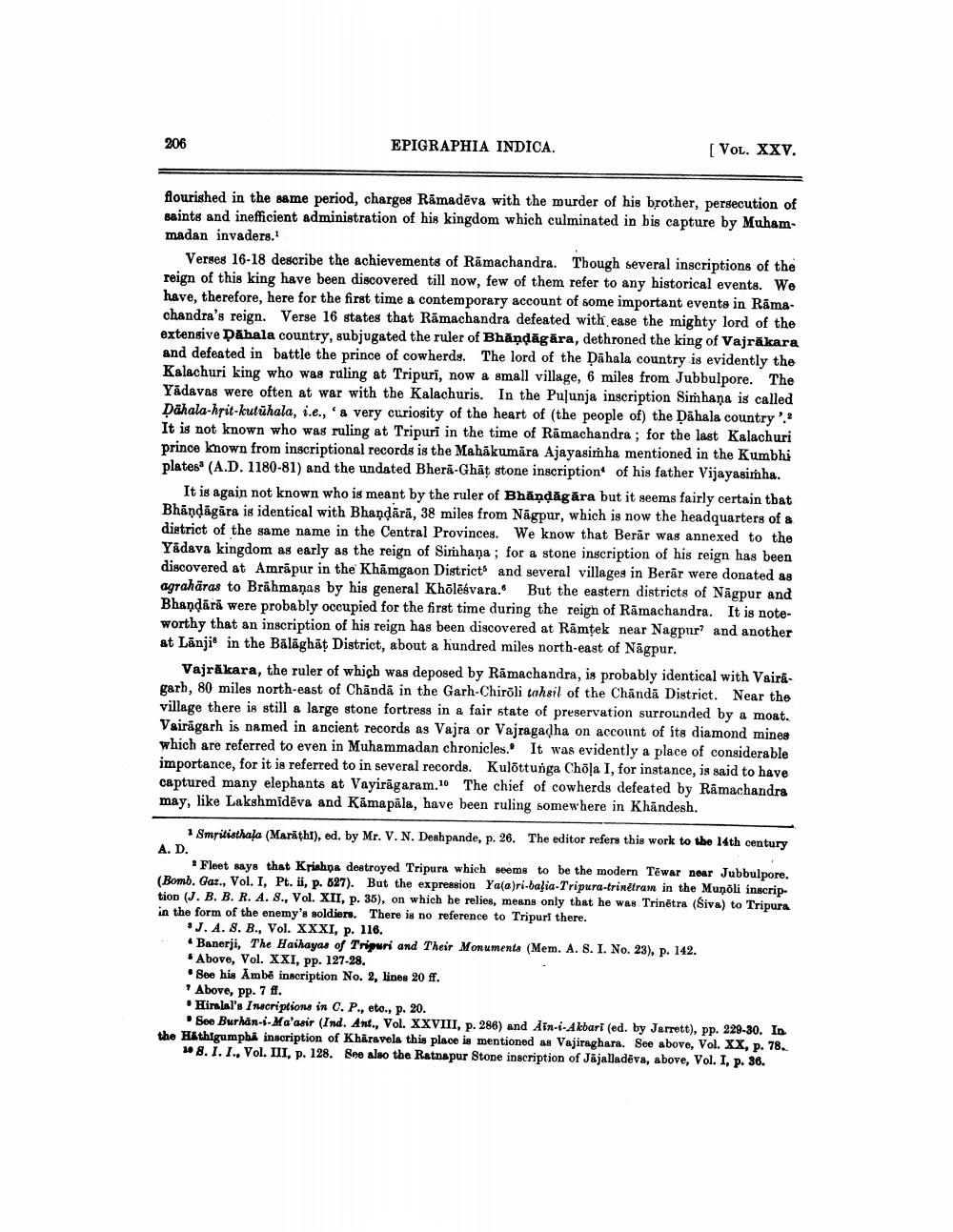________________
206
EPIGRAPHIA INDICA.
[Vol. XXV.
flourished in the same period, charges Ramadēva with the murder of his brother, persecution of saints and inefficient administration of his kingdom which culminated in bis capture by Muhammadan invaders.
Verges 16-18 describe the achievements of Rāmachandra. Though several inscriptions of the reign of this king have been discovered till now, few of them refer to any historical events. We have, therefore, here for the first time a contemporary account of some important events in Ramachandra's reign. Verse 16 states that Ramachandra defeated with ease the mighty lord of the extensive Dahala country, subjugated the ruler of Bhāņdāgāra, dethroned the king of Vajrākara and defeated in battle the prince of cowherds. The lord of the Dahala country is evidently the Kalachuri king who was ruling at Tripuri, now a small village, 6 miles from Jubbulpore. The Yadavas were often at war with the Kalachuris. In the Pulunja inscription Simhaņa is called Dähala-hrit-kutūhala, i.e., '& very curiosity of the heart of the people of the Dābala country'. It is not known who was ruling at Tripuri in the time of Ramachandra ; for the last Kalachuri prince known from inscriptional records is the Mahākumăra Ajayasimha mentioned in the Kumbhi platesa (A.D. 1180-81) and the undated Bhera-Ghāt stone inscription of his father Vijayasimha.
It is again not known who is meant by the ruler of Bhāndāgāra but it seems fairly certain that Bhāndāgāra is identical with Bhandārā, 38 miles from Nagpur, which is now the headquarters of & district of the same name in the Central Provinces. We know that Berar was annexed to the Yadava kingdom as early as the reign of Simhana ; for a stone inscription of his reign has been discovered at Amräpur in the Khāmgaon Districts and several villages in Berār were donated as agrahāras to Brāhmaṇas by his general Khõlēsvara. But the eastern districts of Nāgpur and Bhandārā were probably occupied for the first time during the reign of Ramachandra. It is noteworthy that an inscription of his reign has been discovered at Ramtek near Nagpur? and another at Lānji in the Bālāghāt District, about a hundred miles north-east of Nāgpur.
Vajrākara, the ruler of which was deposed by Ramachandra, is probably identical with Vairagarh, 80 miles north-east of Chändå in the Garh-Chiroli tahsil of the Chånda District. Near the village there is still a large stone fortress in a fair state of preservation surrounded by a most. Vairāgarh is named in ancient records as Vajra or Vajragadha on account of its diamond mines which are referred to even in Muhammadan chronicles. It was evidently a place of considerable importance, for it is referred to in several records. Kulottunga Chõļa I, for instance, is said to have captured many elephants at Vayirāgaram.10 The chief of cowherds defeated by Ramachandra may, like Lakshmidēva and Kāmapāla, have been ruling somewhere in Khandesh,
1 Smritisthala (Marathi), ed. by Mr. V. N. Deshpande, p. 26. The editor refers this work to the 14th century A. D.
Fleet says that Krishna destroyed Tripura which seems to be the modern Tewar near Jubbulpore. (Bomb. Gaz., Vol. I, Pt. ii, p. 627). But the expression Yala)ri-balia-Tripura-trinatram in the Munõli inscrip tion (J. B. B. R. A. 8., Vol. XII, p. 35), on which he relies, means only that he was Trinētra (Siva) to Tripura in the form of the enemy's soldiers. There is no reference to Tripuri there.
J.A.S.B., Vol. XXXI, p. 116. • Banorji, The Haihayas of Tripuri and Their Monuments (Mem. A. S. I. No. 23), p. 142. Above, Vol. XXI, pp. 127-28.
See his Ambe inscription No. 2, lines 20 ff. * Above, pp. 7 f. • Hiralal's Inscriptions in C. P., eto., p. 20.
. See Burhan-s-Ma'asir (Ind. Ant., Vol. XXVIII, p. 286) and Ain--Akbari (ed. by Jarrett), pp. 229-30. In the Hathtgumpba inscription of Khiravels this place is mentioned as Vajiraghara. See above, Vol. XX, p. 78..
108. I. I., Vol. III, p. 128. See also the Ratnapur Stone inscription of Jajalladeva, above, Vol. I, p. 36.




